Looking for a home UPS that is smart
- Thread starter blr_p
- Start date
You are using an out of date browser. It may not display this or other websites correctly.
You should upgrade or use an alternative browser.
You should upgrade or use an alternative browser.
So did you buy this ?Luminous has an 'i' variant of the Zelio now. I cannot understand why this variant even exists. From what i can tell it has the same features as the wifi model except, it does not work with wifi but instead uses bluetooth. This limits the range and seems like a regressive step.
Was it so difficult to get the wifi model working that they opted after to release a bluetooth version instead
if yes,then review would be great.
blr_p
Quasar
No, will mostly likely be the Flinn once i figure out venting. Why is it taking so long ? because there is a learning curveSo did you buy this ?
if yes,then review would be great.
The advantage is it can handle a load of 3kW so i could use it for two floors in the future if required. Play with solar too. The second floor isn't given for now but its an option in the future if the need arises.
I wish Flin offered a model that allowed to configure between two & four battery systems instead of forcing to buy either a two battery or four battery inverter model.
So did you buy this ?
if yes,then review would be great.
Luminous Zelio WiFi. The F stands for frustration.

Don't buy unless you like frustration.
blr_p
Quasar
Made another batch of clear ice and melted it. Ended up about a litre. This time i took care to let the ice melt a bit so as to reduce any contamination with cloudy ice. It's easy, just let it sit out and shave away towards the clear part. Rinsed out the container it would melt in as well and hit zero TDS 
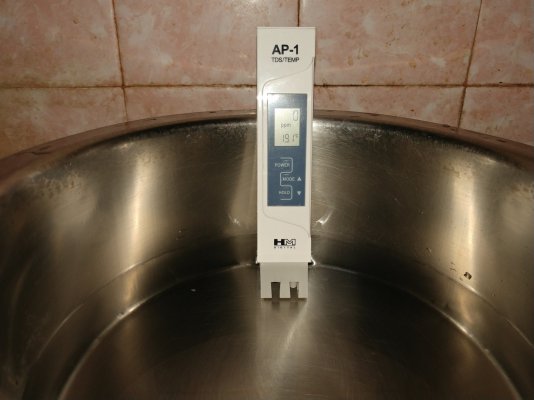
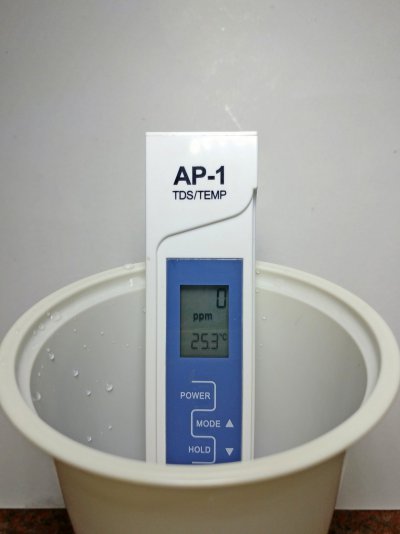
What is zero TDS and did i really make zero TDS water ? well, not quite. Technically, zero TDS means water with a conductivity of 0.05 micro siemens. This is ultra pure water. So what is the conductivity of my water.
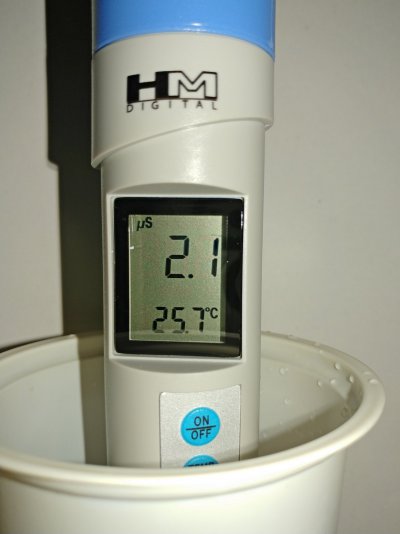
2.1 micro siemens. So zero TDS is 42 times purer.
And what about the TDS
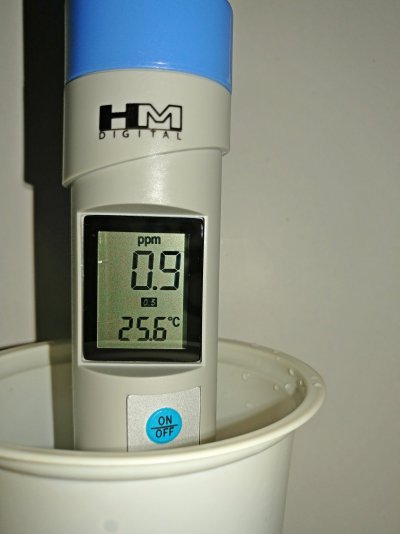
0.9 TDS
This meter has more resolution, adds a decimal point. The cheaper ones round down anything that is less that 1.00 TDS as zero. They do whole numbers only so aren't sensitive enough below 1 TDS.
I tested the total hardness in CaCO3 and it worked out to 1mg/L or 1ppm.
Starting from aquaguard water of TDS 145 and total hardness somewhere between 125-150 mg/L (ppm) of total hardness down to 0.9 TDS and 1mg/L total hardness. This is pretty good for a home effort i'd say.
I went looking for distilled water again and picked up a 1L & 5L from an Indian Oil petrol bunk. Last attempt from BP petrol bunk was a reject, so will this brand be better ?
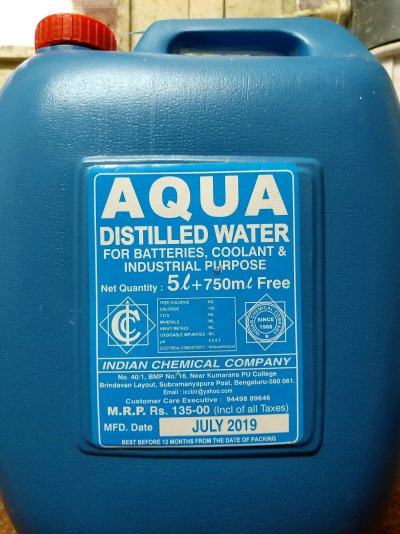
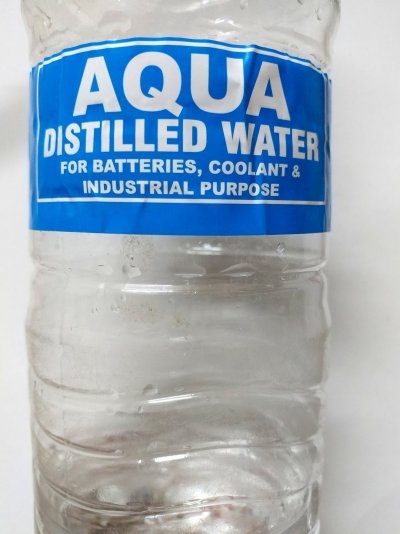
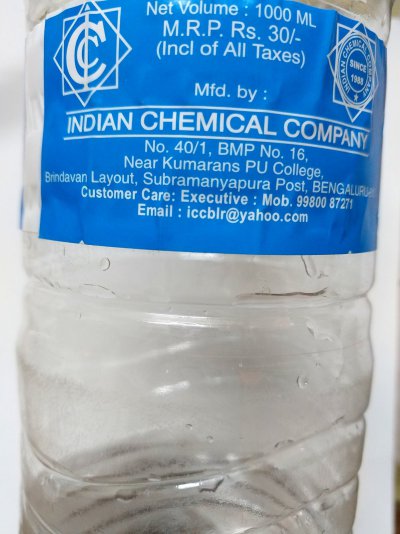
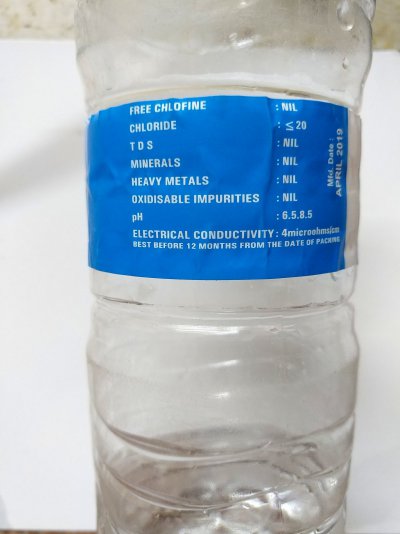
Looking at the label, this Indian chemical company shows more info. Says they've been in the business since 1988, that's got to count for something.
Not only is there a manufacture date, there is also a best before date. Unlike the last product, this company states their water is only good for a year from manufacture. They also state their water is zero TDS and de-mineralised. No idea what free "chlofine" is, chlorine maybe, but i'd have liked to have seen nil for chlorides. No idea what unit they are using when they say less than 20. If there are any Chlorides then should get picked up by the meter as they will increase TDS. Chlorides should not exceed 5 ppm or there will be loss of capacity in both plates with the positive losing more.
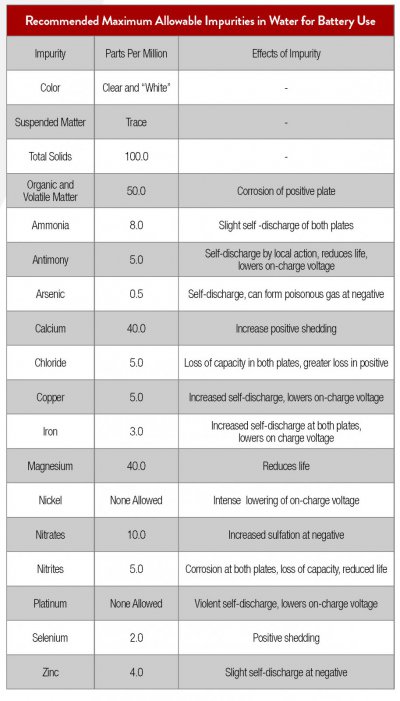
They state the electrical conductivity is 4 micro ohm/cm which is the incorrect unit for conductivity. Conductivity is not expressed in ohms/cm but siemens/cm. Resistance is expressed in ohms. Since 4 mico ohms is mighty low it must be 4 micro siemens. Purer water has higher resistivity and is the reciprocal of conductivity. So how does this one test out ?
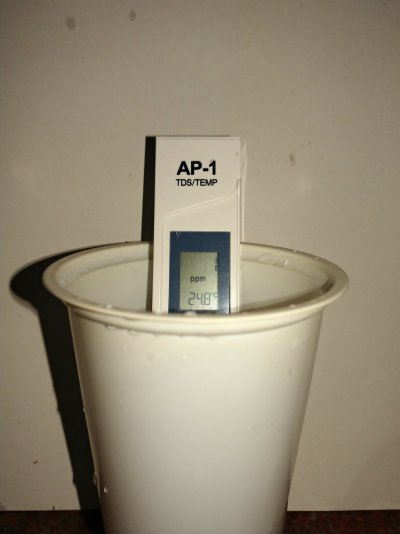
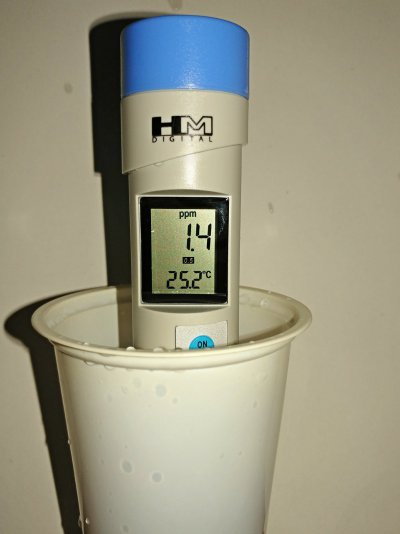
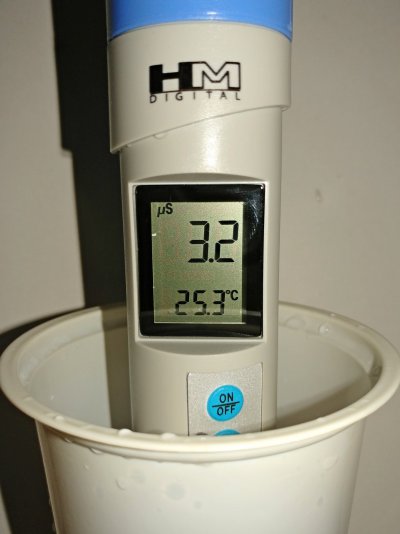
TDS 1 says the AP-1, actually its 1.4 says the other. So any TDS under 1.5 i'm guessing gets rounded down to 1 on the AP-1. The conductance is 3.1 uS so that is within spec. The total hardness is zero.
Compared to the last bottle i got this one is way better.
It has less hardness than my clear ice sample but i got it beat for TDS & conductivity.
Conductivity seems a more sensitive way to measure water purity than TDS at near zero TDS.
EC is the norm in the EU. The Americans use TDS and complicate things. TDS can use different standards, 442, NaCl & KCl. Unless the specific std is mentioned a TDS count is meaningless. EC is simpler and does not depend on anything else. TDS is EC times some factor.
The setting of 0.5 refers to NaCl standard. If a TDS meter goes up to 5000 ppm like the AP-1 then its using the NaCl standard which has a 0.5 conversion factor between conductivity & TDS. With HM meters conductivity is roughly twice TDS.
Is there a correlation between TDS & hardness? Samples i've tested show a close correlation until they don't. Last sample of distilled water i got had a TDS of 23 but total hardness was 2 mg/L. So TDS & Hardness are not always fully equivalent. There could be other things in the water contributing to TDS but not coming from hardness.
Still on the lookout for Exide distillo, no exide care nearby had it.
Want to try deionised water as well if it can be had at a decent price.



What is zero TDS and did i really make zero TDS water ? well, not quite. Technically, zero TDS means water with a conductivity of 0.05 micro siemens. This is ultra pure water. So what is the conductivity of my water.

2.1 micro siemens. So zero TDS is 42 times purer.
And what about the TDS

0.9 TDS
This meter has more resolution, adds a decimal point. The cheaper ones round down anything that is less that 1.00 TDS as zero. They do whole numbers only so aren't sensitive enough below 1 TDS.
I tested the total hardness in CaCO3 and it worked out to 1mg/L or 1ppm.
Starting from aquaguard water of TDS 145 and total hardness somewhere between 125-150 mg/L (ppm) of total hardness down to 0.9 TDS and 1mg/L total hardness. This is pretty good for a home effort i'd say.
I went looking for distilled water again and picked up a 1L & 5L from an Indian Oil petrol bunk. Last attempt from BP petrol bunk was a reject, so will this brand be better ?




Looking at the label, this Indian chemical company shows more info. Says they've been in the business since 1988, that's got to count for something.
Not only is there a manufacture date, there is also a best before date. Unlike the last product, this company states their water is only good for a year from manufacture. They also state their water is zero TDS and de-mineralised. No idea what free "chlofine" is, chlorine maybe, but i'd have liked to have seen nil for chlorides. No idea what unit they are using when they say less than 20. If there are any Chlorides then should get picked up by the meter as they will increase TDS. Chlorides should not exceed 5 ppm or there will be loss of capacity in both plates with the positive losing more.

They state the electrical conductivity is 4 micro ohm/cm which is the incorrect unit for conductivity. Conductivity is not expressed in ohms/cm but siemens/cm. Resistance is expressed in ohms. Since 4 mico ohms is mighty low it must be 4 micro siemens. Purer water has higher resistivity and is the reciprocal of conductivity. So how does this one test out ?



TDS 1 says the AP-1, actually its 1.4 says the other. So any TDS under 1.5 i'm guessing gets rounded down to 1 on the AP-1. The conductance is 3.1 uS so that is within spec. The total hardness is zero.
Compared to the last bottle i got this one is way better.
It has less hardness than my clear ice sample but i got it beat for TDS & conductivity.
Conductivity seems a more sensitive way to measure water purity than TDS at near zero TDS.
EC is the norm in the EU. The Americans use TDS and complicate things. TDS can use different standards, 442, NaCl & KCl. Unless the specific std is mentioned a TDS count is meaningless. EC is simpler and does not depend on anything else. TDS is EC times some factor.
The setting of 0.5 refers to NaCl standard. If a TDS meter goes up to 5000 ppm like the AP-1 then its using the NaCl standard which has a 0.5 conversion factor between conductivity & TDS. With HM meters conductivity is roughly twice TDS.
Is there a correlation between TDS & hardness? Samples i've tested show a close correlation until they don't. Last sample of distilled water i got had a TDS of 23 but total hardness was 2 mg/L. So TDS & Hardness are not always fully equivalent. There could be other things in the water contributing to TDS but not coming from hardness.
Still on the lookout for Exide distillo, no exide care nearby had it.
Want to try deionised water as well if it can be had at a decent price.
Last edited:
Luminous Zelio WiFi. The F stands for frustration.
Don't buy unless you like frustration.
Can you provide any specifics? I was thinking of buying the Zelio+ 1100 without Wifi.
See posts #34 through #39 in this thread. I have given up waiting for that damn OTP. The non WiFi version might be OK.Can you provide any specifics? I was thinking of buying the Zelio+ 1100 without Wifi.
See posts #34 through #39 in this thread. I have given up waiting for that damn OTP. The non WiFi version might be OK.
Ah ok, thought it was something else. Thanks.
blr_p
Quasar
Exide Solartron Data sheet.pdfI wish the maintenance free batteries will last that long. Even single digit deep cycles is enough to have a impact on battery life and their life more so depends on ambient temperature, works best for climate controlled rooms.
Catalog says it can handle frequent deep cycles and its less sensitive to temperature changes. Check these graphs out for Solartron
Over a thousand cycles at 80% discharge. My staircase room is as climate controlled as it gets. No more than 2-3 degrees variance between day & night.
Highest i saw it go was 32 degrees C this May. This May was very hot.
Question is how much more hot will this staircase room get with the Flinn in there. Whether I need to install an extractor fan during the hot months ?
A vent on the door and an extractor fan higher up on the opposite wall running on a timer for 12h during the hot months.
And to figure out how to program the Flinn to these specs.
Imagine 2 x 200 AH's worth is going to be pricey. Probably more without exchange of an older battery of similar specs.
Let's see what their warranty terms are like.
No solar panel attached ? no warranty ? or what
The interesting thing is comparing the weight of the EL 200 AH to the Solartron 200 AH
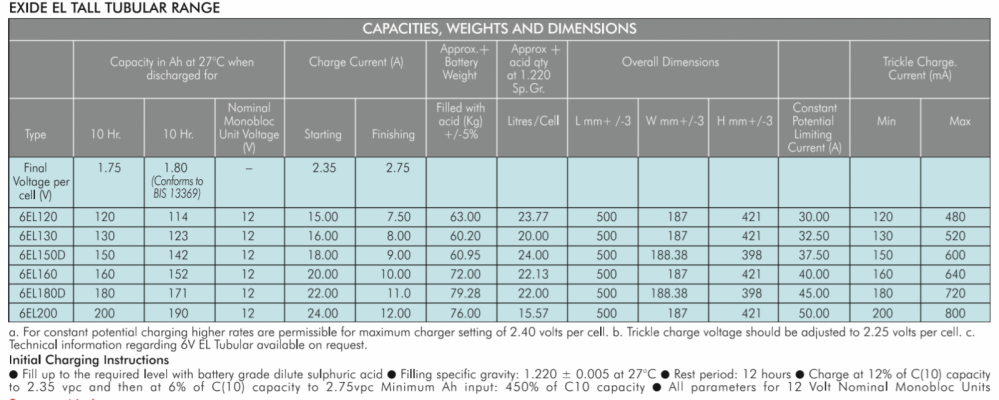
Calculating volume for the two batteries. The Solartron has more depth. 10cm more. Making the volume for the 200 AH 30% larger than the equivalent EL 200 AH
The EL weighs 76 kg, the solartron at 84 kg
Gel is more dense than acid.
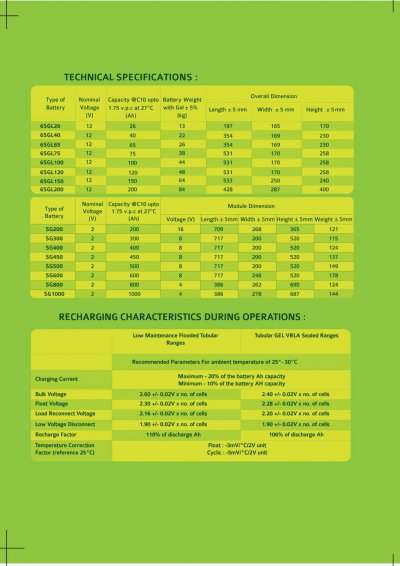

Above is from an older catalog showed the solartron 200 AH at 72 kg. Whether that was a typo
Last edited:
That exide Solatron does have good spec but I still not convinced, may be it can last that long, Luminous 60 month warranty solar tubular battery advertise as 1500 cycles despite weighing less then exide 6LMSL series which have advertised as 1200 cycles. But I am sure the flooder batteries will out last the gel batteries. Mobile towers, railways still use flooded 2v tubular batteries no one uses gel batteries.
They are also like 30 % more expensive then 6LMS series.
Flin will be venting hot air at heavy load but if there is a high enough ceiling and if let the door open under your stair case area, then it should rise up along with H2.
Flin as settings for low voltage cut off, so if the battery voltage drops below the set parameter it can either switch to Mains power or shutdown the output if their is No mains or solar.
It will also take into consideration the load connected when displaying the battery state of charge, it has a rough idea that the lower battery voltage is due to heavy load vs the low battery voltage with minimal load.This is only for the display. When the voltage goes to 21v to 24v or 42v to 48v user configurable for 2 or 4 battery system respectively, it will shut down the output or switch to Mains.
Update: So I had kept 80k aside for the 4 x 200ah tubular batteries which where my last choice, Idealy would like lithium batteries but they are still too expensive. Since there was practically no power cuts. I went and put a 200L solar water heater and a pressure boosting Pump and a 60Liter pressure tank, all totaling about 1lakh or so with zero labor, all plumbing connections where done by me and my dad. I broke a finger in the process.
No longer need to wait for geyser to heat up after some one else takes a bath and off course the reduced power bill. Also because of pressure boosting pump, I can use aerators will 1l to 3l min water flow, thus also saving water, compared to the earlier 10 to 15l/ min water flow.
While the lonely Flin is mounted with all connections made including a self made marine plywood battery box, minus the battery and solar panels.
Was trying to procure Lifep04 bare cells, some advertised as BIS certified, If I make my own battery pack they work out about 60% more expensive then exide 6lms, including BMS boards for each cell in series, the data sheet the indian sellers provide is basically cut copy paste from Chinese sellers. So not really sure about the cycle life claims.But Just thinking about no fans or maintenance makes me won't to plunge but need more proof about the cycle life, worst case is that they match the exide cycle life.
They are also like 30 % more expensive then 6LMS series.
Flin will be venting hot air at heavy load but if there is a high enough ceiling and if let the door open under your stair case area, then it should rise up along with H2.
Flin as settings for low voltage cut off, so if the battery voltage drops below the set parameter it can either switch to Mains power or shutdown the output if their is No mains or solar.
It will also take into consideration the load connected when displaying the battery state of charge, it has a rough idea that the lower battery voltage is due to heavy load vs the low battery voltage with minimal load.This is only for the display. When the voltage goes to 21v to 24v or 42v to 48v user configurable for 2 or 4 battery system respectively, it will shut down the output or switch to Mains.
Post automatically merged:
Update: So I had kept 80k aside for the 4 x 200ah tubular batteries which where my last choice, Idealy would like lithium batteries but they are still too expensive. Since there was practically no power cuts. I went and put a 200L solar water heater and a pressure boosting Pump and a 60Liter pressure tank, all totaling about 1lakh or so with zero labor, all plumbing connections where done by me and my dad. I broke a finger in the process.
No longer need to wait for geyser to heat up after some one else takes a bath and off course the reduced power bill. Also because of pressure boosting pump, I can use aerators will 1l to 3l min water flow, thus also saving water, compared to the earlier 10 to 15l/ min water flow.
While the lonely Flin is mounted with all connections made including a self made marine plywood battery box, minus the battery and solar panels.
Was trying to procure Lifep04 bare cells, some advertised as BIS certified, If I make my own battery pack they work out about 60% more expensive then exide 6lms, including BMS boards for each cell in series, the data sheet the indian sellers provide is basically cut copy paste from Chinese sellers. So not really sure about the cycle life claims.But Just thinking about no fans or maintenance makes me won't to plunge but need more proof about the cycle life, worst case is that they match the exide cycle life.
Last edited:
blr_p
Quasar
That exide Solatron does have good spec but I still not convinced, may be it can last that long, Luminous 60 month warranty solar tubular battery advertise as 1500 cycles despite weighing less then exide 6LMSL series which have advertised as 1200 cycles. But I am sure the flooder batteries will out last the gel batteries. Mobile towers, railways still use flooded 2v tubular batteries no one uses gel batteries.
They are also like 30 % more expensive then 6LMS series.
The NXT series are gel but the cycles in a online ups environment are less. 400 - 700 at 80% DoD
Now the Solar 6LMS series gets much more
Let's compare with the Solatron
Looks very similar doesn't it. In fact the 20% discharge on the solatron beats the flooded one
Post automatically merged:
Let's see what deep cycle gel batteries from other companies can deliver
Trojan AGM Solar
The NXT are AGM but i don't think the solartron are AGM, they are just Gel. But this Trojan seems to deliver 1000 cycles at 80% DoD. Here's the kicker, their 200 AH C20 weighs only 59 kg (!)
What about Trojans deep cycle Gel batteries ?
This one only gets half as many cycles for some reason. Here their 12 V 200 AH weighs 76 kg which is closer to the Solartron's weight. Hmm
Last edited:
Are we to believe exide india which has nothing to do with Exide US has the best gel based lead acid battery out there. Neverthless its 30% more expensive closer to Lifep04 prices.
Gel based ones have a big if one its cycle life because of the temperature factor, they do feel warmer to touch compared to flooded ones.
Solatron capacity is calculated when discharged to 1.75v/cell where as 6LMS capacity is discharged to 1.8v/cell big difference( less if calculated as per BIS13369), you can see the exide powesafe 1.8v vs 1.7v runtime @ 600min is c10 the date is in constant power as in watts, which is V*A.

Gel based ones have a big if one its cycle life because of the temperature factor, they do feel warmer to touch compared to flooded ones.
Solatron capacity is calculated when discharged to 1.75v/cell where as 6LMS capacity is discharged to 1.8v/cell big difference( less if calculated as per BIS13369), you can see the exide powesafe 1.8v vs 1.7v runtime @ 600min is c10 the date is in constant power as in watts, which is V*A.
Last edited:
blr_p
Quasar
Why not ? this isn't rocket science. Gel batteries came out in the 70s. Exide has partnerships with other companies. Fifty years later India has surely caught up. Exide is more credible than Luminous.Are we to believe exide india which has nothing to do with Exide US has the best gel based lead acid battery out there.
Another powersafe battery for online UPS, this is the XHD tubular gel which seems similar to the solatron. But the max size is only 165 AH whose weight is similar to the Solatron 150 AH
Here the 80% DoD is 600 - 1000 cycles compared to fewer for the NXT range
The difference with XHD is torr tubes. Why that increases cycle life i'm not sure.
The point here is if an online UPS VRLA battery can touch a 1000 cycles then why is it so hard to believe a similar good quality solar VRLA battery in an offline UPS application cannot do it

There is no reason a well constructed VRLA battery cannot match a flooded battery if temperatures are not too high. If there is careful charging with no over charging. So if the operating temps is 40 degrees C then flooded is the better choice. But closer to 30 the comparison could be more evenly matched.
What has me bothered is the float service life. First the NXT
About 2.5 to just under 4 years at 30 degrees C
And next is the XHD
What does this mean ? if battery is stored around the 30 degree C mark its useful life is between 3 - 5 years ??
Forget cycle count, if there is a hard limit built here in terms of life the thing dies before you even get to fully cycle it !!
Why does only the VRLA online series publish float life info and not the solar VRLA.....
From your experience with the APC Smart UPS which is an online UPS, no brainer choice is to go with the flooded EL series and not any VRLA
But does that hold true for offline UPS which is my use case. Flin is not an online UPS. The stress it puts on the battery will be less.
Last edited:
My apc smart ups is not On line but rather its line interactive. I see no reason as to why online or offline ups have anything to do with battery life.
The charge circuitry principal is the same, the smart ups has ability to control the battery voltage and higher quality components vs a typical home inverter.
Online ups AC voltage is more constant because of the dc to ac conversion, so there will be no delay during mains fails and constant output voltage.
Line interactive models stabilze the voltage from mains and also the inverted AC (via battery). But for battery life, I can say that Flin charging circuity is as good as a online ups, minus the battery temperature sensor. I dont think apc Online Ups have that much control over the battery settings.
I think exide markets them differently because lets face it, the local inverters sold in India have some crappy internal designs with huge tolerances. People still buy square wave inverters. I have seen inverters with luminous, microtek casing but with local internal circuits. So exide takes all of those into account for warranty.
Many battery companies in India, give more warranty for solar use, additionaly exide does so for Online ups. Only think I can get from this is that in these two usage scenario the batteries are cycled more often, solar cycles daily. Online and line interactive cycles only during power cut or abnormal voltage vs offline ups only during power fail, but they also have ups mode switch.
We have indoor tempertures of 34c last summer, so vrla is no good. Without active climate control, there is now way we can maintain the temperature at 27c or less.
The charge circuitry principal is the same, the smart ups has ability to control the battery voltage and higher quality components vs a typical home inverter.
Online ups AC voltage is more constant because of the dc to ac conversion, so there will be no delay during mains fails and constant output voltage.
Line interactive models stabilze the voltage from mains and also the inverted AC (via battery). But for battery life, I can say that Flin charging circuity is as good as a online ups, minus the battery temperature sensor. I dont think apc Online Ups have that much control over the battery settings.
I think exide markets them differently because lets face it, the local inverters sold in India have some crappy internal designs with huge tolerances. People still buy square wave inverters. I have seen inverters with luminous, microtek casing but with local internal circuits. So exide takes all of those into account for warranty.
Many battery companies in India, give more warranty for solar use, additionaly exide does so for Online ups. Only think I can get from this is that in these two usage scenario the batteries are cycled more often, solar cycles daily. Online and line interactive cycles only during power cut or abnormal voltage vs offline ups only during power fail, but they also have ups mode switch.
We have indoor tempertures of 34c last summer, so vrla is no good. Without active climate control, there is now way we can maintain the temperature at 27c or less.
blr_p
Quasar
This is tangentially related but things will be looking up for Flin and other made in Taiwan products if this commentator has it right.
China no longer retains a language advantage as most young Taiwanese can speak english these days.
This is how the Made in India Lithum batteries will become available.
China no longer retains a language advantage as most young Taiwanese can speak english these days.
The human material available in India is on a scale and of a quality that any global company would be hard pressed to find elsewhere. For the first time, there has been a sharp acceleration in the interest and investment of Taiwanese companies in India, with the levels of both in 2018 being greater than the total of the previous 51 years. Excellent leadership at both the India mission in Taipei as well as the Taiwan mission in Delhi has played a keystone role in such a development, as has the momentum given by Prime Minister Narendra Modi to the Make in India process. Building on this, a quantum leap needs to get made, such that Taiwanese investment in India gets across the $20 billion mark within two years and $50 billion by 2024.
An advanced Research & Development facility could be set up in Haryana within driving distance of the international airport. Production facilities by Original Equipment Manufacturers would need to be set up near ports, in view of the economies in costs of shipping finished products rather than getting ferried by air. While an R&D facility may be smaller, parks designed for production of components need to be on a substantial scale, as close to 10,000 acres as is feasible in Indian conditions.
This is how the Made in India Lithum batteries will become available.
My exide EL40 finally gave up after 9 years and 10months of use. One of the battery drops voltage on the dime with no load connected. So it was replaced with a pair of 26AH power safe plus batteries. Now the two powersafe batteries have a voltage difference 0.3v after compensating the voltage to the temperature, without the compensation the difference was as much as 0.6v (one was at 13.2v and other at 13.8V). I called exide and the person who visited say its fine but I not sure. The exide person did say to do a load test and see if the battery voltage drops significantly. I will have to do the load test at some point before the warranty period gets over.
Now Exide service person(for stationary storage batteries) itself said he gets about 3 calls a day in Bangalore for battery trouble and 90% of the time its for sealed batteries failing within warranty.
Now I did buy this battery knowing the crap reputation because its just never going to be discharge beyond 30min that to when the maintance cleaning work is done for the main inverter and it will at best power the router and security cameras, which as per APC should provide 10hrs of back up for the said load.
Now Exide service person(for stationary storage batteries) itself said he gets about 3 calls a day in Bangalore for battery trouble and 90% of the time its for sealed batteries failing within warranty.
Now I did buy this battery knowing the crap reputation because its just never going to be discharge beyond 30min that to when the maintance cleaning work is done for the main inverter and it will at best power the router and security cameras, which as per APC should provide 10hrs of back up for the said load.
blr_p
Quasar
Are these the NXT brand or just the regular power safe ?My exide EL40 finally gave up after 9 years and 10months of use. One of the battery drops voltage on the dime with no load connected. So it was replaced with a pair of 26AH power safe plus batteries. Now the two powersafe batteries have a voltage difference 0.3v after compensating the voltage to the temperature, without the compensation the difference was as much as 0.6v (one was at 13.2v and other at 13.8V). I called exide and the person who visited say its fine but I not sure. The exide person did say to do a load test and see if the battery voltage drops significantly. I will have to do the load test at some point before the warranty period gets over.
Now Exide service person(for stationary storage batteries) itself said he gets about 3 calls a day in Bangalore for battery trouble and 90% of the time its for sealed batteries failing within warranty.
Now I did buy this battery knowing the crap reputation because its just never going to be discharge beyond 30min that to when the maintance cleaning work is done for the main inverter and it will at best power the router and security cameras, which as per APC should provide 10hrs of back up for the said load.
How long have you had them and let us know how your load test goes
rdst_1
Juggernaut
The batteries are the only reason I can't go for solar at this stage no matter how much I want to as it doesn't make economic sense for me because govt supplied electricity is very cheap for me. I want to go for solar for reliability and clean ( no voltage fluctutations) electricity as well as lowering the carbon cost. However, unless Li-ion batteries become affordable or I can find some cheaper way of storage, I don't think I can make the switch to solar. In my case, I am thinking of battery life as maximum 5 years and for me the costing comes out as same considering today's tariff in my state and hence there is no break-even in 7-10 years as it is for people in other states. Sure, the tariffs will rise but the interest I get from the bank on the 5-6L that I will need to invest right now should easily cover up the inflation in the tariffs.
I was looking at storing solar energy as compressed air and will have to do more research on that aspect and see if it can work for me.
I was looking at storing solar energy as compressed air and will have to do more research on that aspect and see if it can work for me.
No these are regular power safe plus series, the NXT series was 20% to 25% more expensive. I installed them 10 days back, one box lacked the required screws for the terminals which the Exide personal replenished with a bunch more screws.Are these the NXT brand or just the regular power safe ?
How long have you had them and let us know how your load test goes
Sealed batteries should be avoided like plague if its your primary battery. I went for it because the EL26 or the 6LMS 20AH is out of stock, with a lead time of 10 days it has to come from pune, while the power safe series is made in hosur. Ever since one month, after the substation had a fire in their 20MVA transformer which in turn screwed the 220kv transformer, I have had power cuts for atleast 2hrs a day almost daily,this constant cycling of the very old EL40 killed it. Other reason was new EL40 costs 7k+ each vs this power safe was cheapest option considering the charge rate of my APC and it costed 2.4k each. They took the EL40 back for 1k each, some of other dealers where only willing to give Rs 600 to Rs700 for each battery. Just after installing the batteries, the power cuts stopped literally the very next day. Hence couldn't do a discharge test.
Lithium batteries to be specific lifepo4, is currently around 45% more expensive. But they last atleast double the years, with good ones lasting as much as 20 years.The batteries are the only reason I can't go for solar at this stage no matter how much I want to as it doesn't make economic sense for me because govt supplied electricity is very cheap for me. I want to go for solar for reliability and clean ( no voltage fluctutations) electricity as well as lowering the carbon cost. However, unless Li-ion batteries become affordable or I can find some cheaper way of storage, I don't think I can make the switch to solar. In my case, I am thinking of battery life as maximum 5 years and for me the costing comes out as same considering today's tariff in my state and hence there is no break-even in 7-10 years as it is for people in other states. Sure, the tariffs will rise but the interest I get from the bank on the 5-6L that I will need to invest right now should easily cover up the inflation in the tariffs.
I was looking at storing solar energy as compressed air and will have to do more research on that aspect and see if it can work for me.
In the recent solar expo held in bangalore last month the best battery price I got from local suppliers was Rs250 per 32650 cylindrical cell each with a capacity of 5ah to 6ah, at quantity of 500 cells which is equivalent to putting 4 x 200ah lead acid batteries. Lithium 32650 cells would cost Rs125000 vs lead acid which would cost 80k, lithium further needs a BMS which would cost around 7k to 10k for a good one.
But this 32650 cell solution is not that feasible for large energy storage because of the no of cells involved and BMS cannot balance each and every cells, you can do it but it would be a wire mess. Tesla for eg does it but there batteries are exotic, the very best, so they can balance a bunch of cells in parallel vs the crappy no name Chinese cells which can fail or have different voltages per cell packs. Even if you buy from china from the OEM, I saw videos where out of 1000 cells only 4 cells would have true rated capacity while others remaining 996 cells would have a capacity of 20% less brand new. So when I asked local supplies about this they said they can grade the batteries individually right in front of me to get even capacity packs.
Other options are the prismatic type cells a supplier quoted a price of 4.5k for 100AH cells, you will need 32 cells which would cost around 1.5lakh vs for equivalent of 4x 200ah lead acid battery at 80k. Again these are prices for bare cells you will additionally need a BMS and battery interconnect cables or copper plates. I was fine with going for just16 cells but unfortunately they have a minimum quantity purchase, so how to get around this, well you can buy 20ah batteries or 40ah batteries, it will increase the cost but atleast they will sell them but no one has such small capacities in ready stock, atleast not the people I asked. IF one has to go lithium for energy storage you have to go with Lifep04 or LTO chemistry only these cells have high charge/discharge cycle life.
One greedy manufacturer was Okaya batteries who wanted a minimum order of 50 pieces of 12.8v lifpo4 batteries (with 4 cells inside along with bms), so out of the question for individual use.
So with my Exide EL40 failing abruptly I had no choice but to go for lead acid batteries again. I also now have the 4 x Exide 150AH solar batteries sitting in the battery box, they arrived along with the 2 powersafe batteries. More on this later.
Last edited:
blr_p
Quasar
Simulate it, turn off the mains switch.Just after installing the batteries, the power cuts stopped literally the very next day. Hence couldn't do a discharge test.
26AH x 2 is 52 * 24 = 1,248 W of which de-rated to 75% is 936 W (sealed batteries derate to 75% for a 5 - 10h run with C20's)
A 200W load should last around 4.5 h this is when they are fully primed or around 50 cycles
Anything higher will result in disproportionately shorter run times.
Since you only got them ten days ago they haven't got enough cycles in so its likely run time will be shorter.
Let's see how much shorter..
And does Exide honor these warranty claims or find some way to weasel out of it ?Now Exide service person(for stationary storage batteries) itself said he gets about 3 calls a day in Bangalore for battery trouble and 90% of the time its for sealed batteries failing within warranty.
Given how careful you are i doubt you will be seeing him any time soon

I was measuring temperature ranges for a metal box outside which you strongly discouraged for storing batteries.
Right now low is around 18 degrees C and high can be as much as 35 if the sun shows up for a cpl of hours. That is an 18 degree range in temperature for the month of Nov which was quite cool . In the hotter months i expect highs will definitely cross 40 degrees C and remain there for a few hours. So the range could be larger than 20 degrees per day. Not good for battery longevity and even worse for sealed batteries. Tell me how many people are even aware that such wide temperature ranges are bad fr battery life. ?
During cloudy days daily temperature range is still a good ten degrees.
In the broom closet the temperature range is just a couple of degrees. So that is where the solartrons will live. But i need to figure out some climate controlled cooling with fans to compensate for the Flinn heating up. I just need to drop the temps by 5 degrees.
Last edited:



